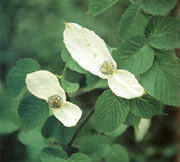|
The single-leafed grass: Kingdonia uniflora
Current Condition: rare species. An autogenus plant indigenous to China, it is now only found in Shanxi, Gansu, Sichuan and Yunnnan. In the subalpine and alpine mountains, the single-leafed grass grows in an shadowy and damp environment with thick humus horizon; therefore, its seeds rarely matures. Its reproduction depends upon the rhizomoid; and it has weak natural regeneration ability. Because of human destruction to the forest and vegetation as well as collection, its number and distribution area decreased greatly.
Value and Significance of Protection: the morphological characteristics of its foliage leaf venation, rhizome and perianth are all quite different from other genera of the family. So, this primitive angiosperm has great scientific significance to uncover the evolution of angiosperm and the phylogeny. The plant as a whole is used in medicine.
Geographical Distribution: in the coniferous forest and theropencedrymion of the sub-alpine and alpine mountains at an altitude of 2200 to 3975meters.
The Chinese dove tree: Davidia involucrata Baillon
Current Condition: rare species. An autogenus plant peculiar to China, the Chinese dove tree is a relict of the palaeotropical flora in the tertiary period as well as a world-famous ornamental plant. Due to over-logging and transplantation of wild saplings, both the number and distribution area of wild Chinese dove tree are very small now. If protection measures are not timely taken, the species may well be replaced by other broadleaved trees.
Value and Significance of Protection: the Chinese dove tree is an ancient precious rare plant. During its stage of full bloom, the two distinctive big bracts under the anthodium look very much like a dove in a tree with its wings open; so, it was named the Chinese dove tree and has become a world-famous ornamental tree. Because of its anthodium and morphological characteristics of the flower are different from other genera of the same family, some scholars hold that it is an independent family. For these peculiarities, the Chinese dove tree has great significance to researches on palaeobotanic flora and phylogeny. The fine timber wood of the Chinese dove tree can also be used in furniture. (7.2.2.2 The Chinese dove tree)
Geographical Distribution: distributed in the broadleaved forest or mixed forest of ever-green and deciduous trees at an altitude1450 to 1800meters. In the Wolong natural reserve, it has a natural distribution area of about 70, 000 hectares.
The cork tree: Phellodendron amurense
Current Condition: vulnerable species. It is also named HuangPoluo or Huang Pai in Chinese. The cork tree is a relict of the palaeotropical floran in the tertiary period and a precious timber wood species of China. Due to over-logging, natural resource of this species has become very rare, and the cork tree is apt to become an endangered species.
Value and Significance of Protection: an ancient epibiotic plant, the cork tree has scientific value to researches on palaeobotanical flora, palaeogeography, and the ice age of the quaternary period. Aromatic oil can be abstracted from cork tree leaves; and fixed oil and in the mannitolmannitol are used in industry and medicine.
Geographical Distribution: at an altitude of 1700 to 1859 meters.
Lingchunmu: Euptelea Pleiospermum Hook,f.et Thoms
Current Condition: rare species. Although widely distributed, the growing and natural regeneration of this species has been restricted because of the over-logging of forest, destruction of natural vegetation and the deterioration of natural environment. The distribution area is now shrinking rapidly and its number has already decreased a lot.
Value and Significance of Protection: it is a typical tree species of the East Asia flora and an ancient epibiotic plant; therefore, it has scientific significance to researches on botanical phylogeny and flora. Its beautiful flowers and fruits of the tree also make it an outstanding ornamental tree.
Geographical Distribution: in the mountain sides and valleys at an altitude of 1900 to 3200meters.
WILD ROSE: Rosa rugosa Thunb
Current Condition: endangered species. Although roses are widely cultured in China, wild resource of them is quite limited. In recent years, wild roses are found along the southern coast of Liaoning province and the Jiaodong peninsula of Shandong province. But their number is quite small; and because the careless collection and digging of the local people, natural regeneration has been restricted and distribution area shrank.
Value and Significance of Protection: wild roses have potential gene for cultivating new species. Roses have 0.03% perfume oil that can be used in making high-class perfume, perfumed soap and make-up perfume. It is also used in medicine as it can regulate qi and invigorates the blood and has an effect of astringency. The fruits can be used in food and medicine; the big and beautiful flowers of rose have great ornamental and economical value. In addition, because this species is only distributed in northern coasts and islands, it has certain scientific value for our understanding of botanical flora.
Geographical Distribution: at an altitude of 1500 to 2000 meters.
Taxaceae.The red wood: Metasequoia glyptostroboides Hu et Cheng.Dipteronia dyerana.Pterostyrax psilophylla.The Big-leafed willow: Salix magnifica Schneid
Tetracentron: Tetracentron sinense.The tall gastrodia: Gastrodia elata.The Henry emmenopherys: Emmenopterys henryi.The round-leafed magnolia: Magnolia sinensis.Dysosmatis
|